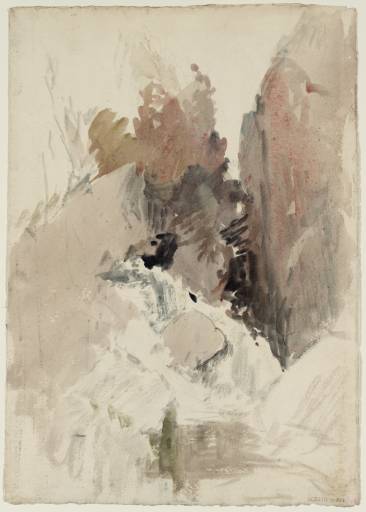Joseph Mallord William Turner Study for 'Rokeby' 1822
Joseph Mallord William Turner,
Study for 'Rokeby'
1822
Joseph Mallord William Turner 1775–1851
Study for ‘Rokeby’ 1822
D25371
Turner Bequest CCLXIII 249
Turner Bequest CCLXIII 249
Pencil and watercolour on white wove paper, 247 x 175 mm
Blind-stamped with Turner Bequest monogram towards bottom right
Inscribed in red ink ‘249’ bottom right
Stamped in black ‘CCLXIII – 249’ bottom right
Blind-stamped with Turner Bequest monogram towards bottom right
Inscribed in red ink ‘249’ bottom right
Stamped in black ‘CCLXIII – 249’ bottom right
Accepted by the nation as part of the Turner Bequest 1856
Exhibition history
1997
Turner’s Watercolour Explorations 1810–1842, Tate Gallery, London, February–June 1997, Southampton City Art Gallery, June–September (78, as ‘Study for “Rokeby”’, 1822, reproduced).
2009
Colour and Line: Turner’s Experiments [fourth hang], Tate Britain, London, December 2009–July 2010 (no catalogue, as ‘Study for “Rokeby”’).
2015
Risk, Turner Contemporary, Margate, October 2015–January 2016 (no catalogue found).
2016
Joachim Koester: The Other Side of the Sky, Turner Contemporary, Margate, February–May 2016 (no catalogue found).
References
1820
A.J. Finberg, A Complete Inventory of the Drawings of the Turner Bequest, London 1909, vol.II, p.833, CCLXIII 249, as ‘A water fall’, c.1820–30.
1997
Eric Shanes, Turner’s Watercolour Explorations 1810–1842, exhibition catalogue, Tate Gallery, London 1997, pp.16–17, 30, 84–6 no.78, as ‘Study for “Rokeby”’, 1822, reproduced p.85, 97 Appendix I ‘Fawkes’, 99 Appendix I ‘Literary and Book Illustrations’, 101 Appendix I ‘Rokeby Illustration’.
2002
Evelyn Joll in Joll and others, Cecil Higgins Art Gallery: Watercolours and Drawings, Bedford 2002, p.272.
2006
Emma House in House, Michael Rudd and Paul Clark, Joseph Mallord William Turner: Tours of Durham and Richmondshire, exhibition catalogue, Bowes Museum, Barnard Castle 2006, p.12.
2013
Emma House in House, Michael Rudd and Tony Seward, Rokeby: Poetry and Landscape: Walter Scott and Turner in Teesdale, exhibition catalogue, Bowes Museum, Barnard Castle 2013, p.31.
This is one of four loose ‘colour beginnings’ related to the 1822 watercolour Rokeby (The Higgins, Bedford),1 which was painted for Turner’s close friend and major patron Walter Fawkes of Farnley Hall in Yorkshire (see David Hill’s overall Introduction to the present section); see also Tate D25408, D25409 and D25411 (Turner Bequest CCLXIII 285, 286, 288). Their connection was established by Eric Shanes.2
The upright finished design shows a rocky gorge with a figure among trees above the fast-flowing River Greta near Rokeby Park in County Durham. Turner had been in the area in 1816; see David Hill’s Introduction to the Yorkshire 4 sketchbook (Tate; Turner Bequest CXLVII) in the ‘Tour of Yorkshire 1816’ section.3 Two boulders in the foreground there are inscribed (slightly inaccurately), as if carved, with lines from the second canto of Rokeby, a long 1813 poem by Sir Walter Scott (1771–1832):
Here, twixt Rock and River grew
A dismal grove of sable yew
With whose sad tints were mingled seen
The blighted firs sepulchar’l green
A dismal grove of sable yew
With whose sad tints were mingled seen
The blighted firs sepulchar’l green
He who winds twixt rock and wave
May hear the headlong torrent rave
May view her chafe her waves to spray
O’er every rock that bars her way
May hear the headlong torrent rave
May view her chafe her waves to spray
O’er every rock that bars her way
Rokeby
The poem deals with events after the 1644 Civil War battle of Marston Moor; another of Turner’s projects for Fawkes was a series of illustrations of the ‘Fairfaxiana’ collection of items owned by General Fairfax, who had been involved in the battle4 (see under Tate D12100; Turner Bequest CLIV B). The Rokeby design was intended as one of seven illustrations to Fawkes’s personal selection from the verses of Scott, Lord Byron (1788–1824) and Thomas Moore (1779–1852),5 all of whom Turner illustrated in other contexts (see for example Meredith Gamer’s ‘Vignette watercolours c.1826–43’ section).
Verso:
Blank; there is some mottled brown and grey watercolour offsetting, possibly from one of the related studies.
Matthew Imms
September 2006
How to cite
Matthew Imms, ‘Study for ‘Rokeby’ 1822 by Joseph Mallord William Turner’, catalogue entry, September 2006, in David Blayney Brown (ed.), J.M.W. Turner: Sketchbooks, Drawings and Watercolours, Tate Research Publication, December 2016, https://www

